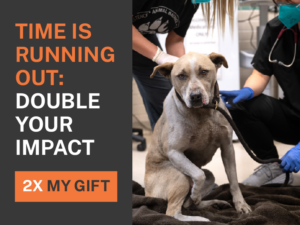Dog-reactive dogs may lunge, whine, bark or growl at other dogs. Some reactive dogs may snap or bite another dog if they get close enough. Managing a reactive dog can be challenging. Follow these tips to help keep your dog safe and happy.
- In general, a dog-reactive dog should be the only dog in the home. Cohabitating with other dogs will be difficult to manage and may cause your dog additional anxiety.
- Never bring your dog to a place where other dogs will be off leash, like a dog park.
- Try to avoid other dogs unless necessary. Every time a dog reacts to another dog, they are more likely to continue repeating that behavior.
- Focus on leash training. Dogs are most likely to be reactive while on leash, so training them to behave while out on a walk is important.
Leash Training Tips
Use a walking tool when working with your dog. Easy-walk or Sensation harnesses are the mostrecommended brands. Make sure you fit the harness properly.
- For the first week, avoid walking your dog in areas where you might encounter other dogs. Choose a quiet area with few distractions.
- While working in quiet areas, practice redirecting cues. You can use these cues to distract your dog from other dogs you may encounter.
- When teaching Look at Me, use treats to lure the dog’s eyes up to make eye contact with you and reward.
- When teaching Touch, hold a treat between your thumb and your palm and hold your hand with the palm out facing your dog. Ask the dog to touch, and reward them as soon as the dog’s nose touches your palm.
- Teach The Name Game. It is important that your dog knows their name on a walk, so you can get them to focus on you by calling their name if they see another dog.
On-Leash Reactivity: The Difference
Some dogs are dog-reactive, and some are on-leash reactive. What is on-leash reactivity, and how does it differ from typical dog reactivity?
If a dog is dog-reactive, they will show reactions to dogs on- or off-leash and generally would prefer not to be around other dogs. It can be difficult to socialize a dog-reactive dog with other dogs as they may have a low tolerance for them.
A leash-reactive dog may show reactivity while on leash; they will pull, growl, bark, and whine if they see another dog while walking on leash. However, a leash-reactive dog may actually be dog friendly when off leash or when given an opportunity to interact with the dog they see. So why do they react when on leash? They may be so excited to meet another dog that they become frustrated when they cannot play with them. Fortunately, you can leash train a leash-reactive dog like a dog-reactive dog.
It can be hard to tell if your dog is dog-reactive or on-leash reactive. If you suspect your pup might want some playmates, seek out an obedience trainer who offers socialization classes, as they may be able to help introduce your dog to other dogs in a safe, controlled setting.
We are always here to help! You can find additional behavior and training resources at pasadenahumane.org/behavior.



